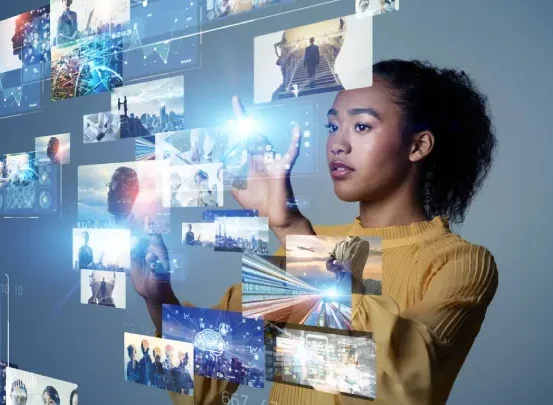As consumers spend more time in the metaverse, it’s only inevitable that businesses would begin to advertise in virtual reality locations. The metaverse provides businesses with a big marketing opportunity because it allows them to provide clients with a highly tailored and engaging experience. Instead of leaving a comment on a company’s Facebook page, as a normal customer may do today, customers could converse with the brand itself, represented by a human figure or avatar, in the future. The metaverse has the potential to permanently alter consumer tastes and purchasing behaviour in ways we can’t yet foresee. To keep their marketing strategy relevant and effective, brands should keep an eye out for developing trends.
What makes the metaverse so appealing?
The enormous financial potential of this technology has prompted some corporations to establish their own “omniverses.” They must recognise that users enter the metaverse to escape from the real world because it affords them the seductive opportunity to create their own personality, their own reality: to show themselves as they “feel” they truly are, elevating the user experience. Brands have recognised the metaverse as a way to generate that aspirational realism and self-expression that users are sometimes unable to develop or translate to their real-life lives.
Here are four ways brands and marketers can prepare for the future of the metaverse now.
Learn about the building blocks.
Web3, blockchain, NFTs, cryptocurrencies, and other connected and related technologies will make up the metaverse. Because no single person can know everything, wise businesses will develop learning communities (interest groups, book clubs, etc.) to assess, experiment with, and invest in related technologies and phenomena on a regular basis. Begin assembling your exploratory team right away.
Make sure you’re familiar with the concept of accessibility.
There isn’t just one type of device in the metaverse. Everyone should be able to access metaverse content on numerous, if not all, devices. Popular VR and AR hardware is available to enhance the metaverse’s user experience, but it is not, and should not be, required to consume content within the metaverse.
Master the fundamentals of interoperability.
The metaverse revolves around interoperability, or the ability for computerised systems to interact and communicate with one another with ease. As a result, being able to produce shared assets is essential for developing metaverse content. By changing your attitude and adopting a digital work ethic that prioritises interoperability now, you’ll be able to create material that can be used in the metaverse later.
Visualize your brand’s future in the metaverse.
While you may not be ready to invest in the metaverse just yet, start thinking about and visualising how your brand will be experienced once you do. To promote inventive thinking, consider creating a pilot experience or even a vision statement. For example, a retailer’s vision might be: “We will be the best destination retailer…in the metaverse.” “We will build outdoor power equipment that helps people maintain their homes…in the metaverse,” a power equipment firm could strive to.
How consumers will connect and engage with Metaverse?
Consumers always tend to like that experience which gives them full satisfaction when purchasing a commodity. Virtual commodities are by their nature interactive. They can help us achieve our goals, overcome obstacles, and express ourselves while keeping us entertained. Since the introduction of microtransactions 15 years ago, we’ve witnessed this truth in gaming culture. Now, blockchain-enabled NFTs (non-fungible tokens) demonstrate this in finance with considerably bigger stakes. Buying items can fill an emotional void, and virtual commodities are the purest example of this. ‘Power-ups,’ such as double experience points in games, better weaponry and armour, or a character’s own unique wardrobe, make us feel cooler, more attractive, and more awesome than we actually are. Thanks to a highly frictionless money exchange for emotion, virtual products deliver rapid gratification.
Metaverse for business
AR, video rendering and enabled graphics is being worked with graphics processing units which allow the tech industry to push boundaries. Millions of people are establishing the framework for a metaverse were moving fluidly between the physical world and virtual space is as natural as sending a text message, thanks to work from home and hybrid working methods.
NFTs are a part of our everyday lives, allowing us to purchase, own, licence, and protect digital assets. Because the 3D data recorded is many orders of magnitude larger than the data sets we handle with 2D objects, the metaverse will stimulate a renaissance of innovation in privacy, security, and data protection. These applications will have an impact on our lives at work and at home as earphones, glasses, and headsets become more affordable.
Is Metaverse safe for brands?
Society has always adopted those measure that gives them safety and a good experience. The Metaverse will be more useful to those people who are born in the generation Z and alpha. The users need to have technical knowledge in blockchain, cryptocurrencies, and non-fungible tokens for the exchange system.
The Metaverse provides limitless possibilities, particularly in the sphere of trade. According to technology firm Wildbytes, 70 per cent of large brands will have a presence in the Metaverse within the next five years. Some companies have already stated that they will release a new product by 2023, while others are exploring the potential of constructing malls, boutiques, and virtual stores where avatars may purchase NFT products and pay in cryptocurrencies.
One of the most extensively invested sectors in the Metaverse is retail. Gucci, for example, has already begun selling its own virtual clothes, the Gucci Virtual 25 sneakers, and H&M has just released its first virtual collection via Nintendo’s social simulation game Animal Crossing.














